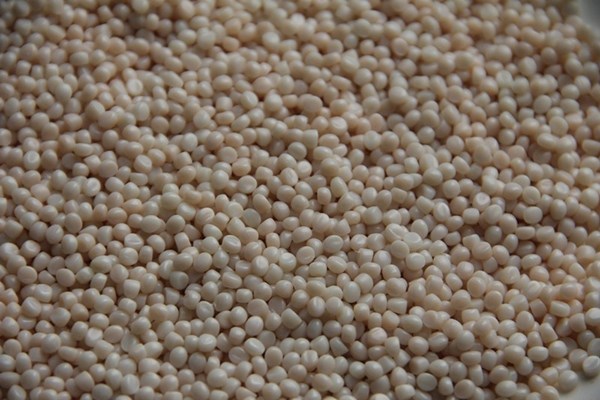Biodegradable plastic market adds a new player in China
Air pollution grabs headlines in China, but a country of 1.35 billion with a growing middle class spending newfound disposable income on single-use disposable plastics is bound to have issues with solid waste as well.

Hoping to address those and tap into increasing regulation of plastics bags in the country, Jinhui Zhaolong High Technology Co. Ltd. offered details on its new 20,000 m.t./yr production line for a biodegradable plastic it’s positioning as a “green” replacement for traditional plastics in a range of products from shopping bags to mulch films. In addition to output, the company touted the production technology for the polybutyrate adipate terephthalate (PBAT), which it dubbed Ecoworld, saying it utilizes a one-step polymerization process.
Janice Li, VP Shanxi Jinhui Group, presented the news at a pre-Chinaplas 2014 press conference sponsored by show organizer, Adsale. Jinhui Zhaolong, which is a wholly owned subsidiary of Chinese coal interest, Shanxi Jinhui Energy Group, was created in 2012 in the Xiaoyi Economic Development Zone.
Jinhui Zhaolong says its initial investment gives it the largest capacity for PBAT in Asia. Globally, BASF is the dominant producer with its Ecoflex brand of PBAT materials. In February 2011, it expanded production of the biodegradable plastic at its Ludwigshafen, Germany facility, boosting output from 14,000 to 74,000 m.t./yr, as well as expanding capacity for its Ecovio material, which blends Ecoflex with polylactic acid (PLA). Elsewhere in Europe, Italy’s Novamont has PBAT production at its biorefinery in Terni, where it manufacturers its Origo-Bi material. That’s based on Eastman Chemical’s Eastar Bio copolyester, which Novamont acquired in September 2004. Started up in 2008, the Terni biorefinery has total annual production capacity of 80,000 m.t./yr for both its PBAT, trade name Origo Bi, and starch-based bioplastic, Mater-Bi.
Targeting PE
Jinhui Zhaolong describes its Ecoworld PBAT as a terpolymer made from 1,4 butanediol, adipic acid and terephthalic acid. It touted its tear resistance and impact strength versus polyethylene, which it’s targeting in applications like mulch film and bags, saying it provides 120% and 130% of the tear resistance and impact strength, respectively, of PE.
The company said its material has been shown to decompose via microorganisms into carbon dioxide and water in 180 days, satisfying European Union EN13432 and U.S. ASTM 6400D biodegradability standards. In addition, it has completed Chinese and FDA food contact requirements. In terms of properties, Ecoworld’s blowmolding grade has a density of 1.26 g/cm3, with a melting point of 115 C.
Using starch and CO2 to create a better barrier
The company also promoted the development of what it called a “degradable composite” barrier material that’s based on polypropylene carbonate (PPC) and made in part from carbon dioxide. This development, was presented by Yuezhong Meng, a professor at Sun Yat-Sen University in Guangzhou.
Meng, who said he has more than 52 patents for the related technology, including three from the U.S., said the finished polymer is composed of about 40-50% carbon dioxide, with a one-step reaction utilized to create the polymer. Meng touted PPC’s oxygen barrier, water permeability, and cost, as compared to competitive barrier materials including PVDC and EVOH.
From a property standpoint, Meng compared the material to polypropylene, noting that it has a process temperature ranging from 170-250 C, with tensile strength of 24.2 (MPa) and elongation at break of 5.64%.
Novomer, Waltham, Mass., which bills itself as converting carbon dioxide into sustainable polymers and chemicals, also markets a PPC created by joining propylene oxide and carbon dioxide in the presence of a proprietary catalyst.
Related Content
Recycled Material Prices Show Stability Heading into 2023
After summer's steep drop, most prices leveled off in the second half.
Read MoreHow to Optimize Injection Molding of PHA and PHA/PLA Blends
Here are processing guidelines aimed at both getting the PHA resin into the process without degrading it, and reducing residence time at melt temperatures.
Read MoreFilm Extrusion: Boost Mechanical Properties and Rate of Composting by Blending Amorphous PHA into PLA
A unique amorphous PHA has been shown to enhance the mechanical performance and accelerate the biodegradation of other compostable polymers PLA in blown film.
Read MoreThe Importance of Mass Balance in Chemical Recycling
Approaches to mass balance can dramatically impact calculations of recycled content.
Read MoreRead Next
Making the Circular Economy a Reality
Driven by brand owner demands and new worldwide legislation, the entire supply chain is working toward the shift to circularity, with some evidence the circular economy has already begun.
Read MoreBeyond Prototypes: 8 Ways the Plastics Industry Is Using 3D Printing
Plastics processors are finding applications for 3D printing around the plant and across the supply chain. Here are 8 examples to look for at NPE2024.
Read More
























